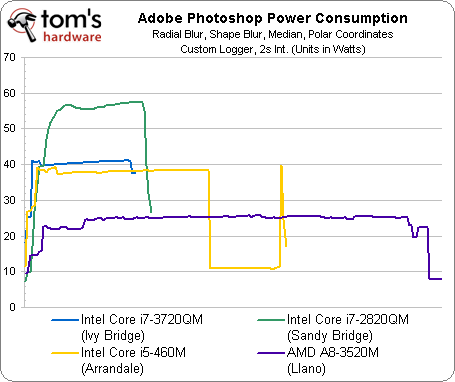Core i7-3720QM: Ivy Bridge Makes Its Mark On Mobility
Benchmark Results: Adobe Photoshop CS 5
Our Photoshop benchmark consists of four threaded filters applied to a large (~15 MB) TIFF image in a script, which effectively demonstrates the performance of each processor in a real-world application. Naturally, the CPUs best optimized for threaded tend to rise to the top.
Unfortunately, that's not the case absolutely. Both the Core i7-3720QM and Core i7-2820QM do really well, the Ivy Bridge-based design trumping Sandy Bridge. As expected, our dual-core Arrandale-based sample performs a lot worse, eating up almost four minutes to finish the same task. But then, surprisingly, AMD's quad-core A8-3520M eats up an additional two minutes.
Seemingly, sharing a 35 W TDP between graphics and processing cores is a real handicap for the APU. So, let's take a look at how utilization and power consumption come into play. In a mobile environment, those two variables are important as well, after all.
As mentioned, our filters are threaded, which explains why even the fastest quad-core chip is pegged at 100% throughout the test. And the performance picture is once again painted by the lines where each CPU drops back to near-zero, indicating the task is complete.
But it takes a look at the power consumption chart to reveal how much battery life each of these platforms is going to gobble up as it gets its job done. The Core i7-3720QM is a 45 W chip, and its system power use hovers in the 40 W range. The older Sandy Bridge-based part, Core i7-2820QM, is also a 45 W processor. Its system power use spikes much higher, though. The Core i5-460M is a 35 W CPU that nearly matches Ivy Bridge's power use, despite its far inferior performance. AMD's A8, also rated for 35 W, clearly underperforms the other contenders. However, it hovers between 20 and 30 W total power use.
Now, that'd be great if the A8 got its job done faster. Using less power over a long period of time doesn't turn out to be a benefit. In terms of energy efficiency, even the Core i7-2820QM outperforms AMD's A8-3520M because it consumes a little more than two times as much power, but finishes the job in one-third of the time. Ivy Bridge improves on that to an even greater degree.
Get Tom's Hardware's best news and in-depth reviews, straight to your inbox.
Current page: Benchmark Results: Adobe Photoshop CS 5
Prev Page Benchmark Results: PCMark 7 Next Page Benchmark Results: WinRAR 4.11-
fstrthnu Would there be a noticeable performance gap between the i7-3720QM and the i7-3612/5QM? I'm trying to decide whether the extra 300 Mhz is worth ~$150 more (which I'm guessing not really)Reply -
s3anister fstrthnuWould there be a noticeable performance gap between the i7-3720QM and the i7-3612/5QM? I'm trying to decide whether the extra 300 Mhz is worth ~$150 more (which I'm guessing not really)Reply
There would be a performance difference in applications that could use the extra MHz (Video games, encoding/decoding) and performance would scale accordingly. Otherwise no you'd likely never notice. -
dragonsqrrl Wow, it looks like Ivy Bridge is a very compelling option in the mobile market. I had no idea the mobile versions of Llano were so performance constrained by their TDP. The graphics performance results are especially interesting. Just turned my whole world view upside down.Reply
Great job. Another excellent review Andrew. -
fstrthnu It looks like the Geforce GT650M in the notebook I'm looking at would bottleneck faster than the processor would, so I guess I'll save $$ thenReply -
DjEaZy ... why there waz no screenshots of picture quality differences in games between intel's HD4000 and AMD's HD6620?Reply -
blazorthon dragonsqrrlWow, it looks like Ivy Bridge is a very compelling option in the mobile market. I had no idea the mobile versions of Llano were so performance constrained by their TDP. The graphics performance results are especially interesting. Just turned my whole world view upside down.Great job. Another excellent review Andrew.Reply
To be fair, it was a low power APU being bench-marked against higher end, higher power, and newer chips. I would be surprised if it won much of anything, besides power usage, against the Sandy and Ivy i7s. A higher TDP mobile A8 might be able to beat HD 4000 if it had 1600MHz or maybe even 1866MHz memory, granted it still wouldn't win in CPU performance. -
ojas Interesting review. But i guess people are likely to point out differences in price (thus affecting performance/$), and RAM speeds, which apparently impact IGP performance.Reply
IIRC, the IGPs on the mobile chips can be OC'd, right?
The Core i7-3720QM particularly shines in tests involving:
Hmmm...wouldn't you agree that "data decryption" should be on this list too? The difference b/w each proc is significant...plus you've got hardware acceleration for AES256 on SB and IB...
Video Transcoding
DX9 Graphics
Web Browsing
I hope the mobile i3s get HD4000...still wondering why the i5s didn't get it... -
DavidC1 Andrew, love the review. But there's what seems to be a big error. You said on the power usage tests that AMD defaults to max battery life while Intel goes to balanced? Looking at World of Warcraft results, it looks like all the other results may be running max battery life mode for the AMD A8 chip.Reply
The i5-460M is faster than A8-3520M, just not that much faster. I have a feeling you need to run the application and gaming tests on max performance all over again. It doesn't matter for the Intel part as Balanced pretty much performs like max performance. -
DavidC1 Also, you need to do a battery life test. Power usage and battery life tests are hard to connect, because of advanced power management techniques and different usage models.Reply


